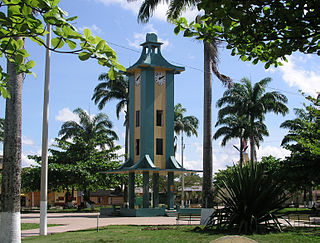See also
- Madre de Deus (disambiguation), same title in Portuguese
Madre de Dios may refer to:
Sierra may refer to the following:
PEM or Pem may stand for:

Madre de Dios is a department and region in southeastern Peru, bordering Brazil, Bolivia and the Peruvian departments of Puno, Cusco and Ucayali, in the Amazon Basin. Its capital is the city of Puerto Maldonado. It is also the third largest department in Peru, after Ucayali and Loreto. However, it is also the least densely populated department in Peru, as well as its least populous department.

The Madre de Dios River is a river shared by Bolivia and Peru which is homonymous to the Peruvian region it runs through. On Bolivian territory it receives the Beni River, close to the town of Riberalta, which later joins with the Mamore River to become the Madeira River after the confluence. The Madeira is a tributary to the Amazon River.
Tambopata can refer to any of the following entities:
Universidad Católica, Spanish for "Catholic university", may refer to:

Puerto Maldonado is a city in southeastern Peru in the Amazon rainforest 55 kilometres (34 mi) west of the Bolivian border, located at the confluence of the Tambopata and Madre de Dios rivers. The latter river joins the Madeira River as a tributary of the Amazon. This city is the capital of the Madre de Dios Region.

The Spanish language employs a wide range of swear words that vary between Spanish speaking nations and in regions and subcultures of each nation. Idiomatic expressions, particularly profanity, are not always directly translatable into other languages, and so most of the English translations offered in this article are very rough and most likely do not reflect the full meaning of the expression they intend to translate.
La Merced may refer to:
Julio Alfredo Jaramillo Laurido was a notable Ecuadorian singer and recording artist who performed throughout Latin America, achieving great fame for his renditions of boleros, valses, pasillos, tangos, and rancheras.
Madre de Dios Island is an island in the Magallanes Region, Chile. It is located west of the Trinidad Channel and Concepción Channel. Madre de Dios Island is composed partly of limestone and has several natural caves. In one of those caves, called the "Cave of the Whales", skeletons of whales 2600 to 3500 years old have been discovered 10 to 30 meters above sea level. In another cave, named Cueva del Pacifico, rock art was discovered in 2006. Many other caves near the coast were used by the indigenous Kaweskar people for burial. One skull found dates back to 4500 years ago. Some caves were used as temporary camps. Since 2008, the island has been protected as a nature reserve.
Don Julio Gualberto García Agapito was a Peruvian environmentalist who was murdered on February 26, 2008 after reporting a shipment of illegally harvested mahogany in Peru. Don Julio was Lieutenant Governor of the town of Alerta in the Tahuamanu Province of Madre de Dios, Peru.
Madre means mother in many Romance languages, and it may also refer to:

The Harakmbut are indigenous people in Peru. They speak the Harakmbut language. An estimated 2,000 Harakmbut people live in the Madre de Dios Region near the Brazilian border in the Peruvian Amazon.
"Mothers of the Disappeared" is a song by Irish rock band U2. It is the eleventh and final track on their 1987 album The Joshua Tree. The song was inspired by lead singer Bono's experiences in Nicaragua and El Salvador in July 1986, following U2's participation in the Conspiracy of Hope tour of benefit concerts for Amnesty International. He learned of the Madres de Plaza de Mayo, a group of women whose children had "forcibly disappeared" at the hands of the Argentine and Chilean dictatorships. While in Central America, he met members of COMADRES, a similar organization whose children had been abducted by the government in El Salvador. Bono sympathized with the Madres and COMADRES and wanted to pay tribute to their cause.
Ese Ejja, also known as Tiatinagua (Tatinawa), is a Tacanan language of Bolivia and Peru. It is spoken by Ese Ejja people of all ages. Dialects are Guacanawa (Guarayo/Huarayo), Baguaja, Echoja, and possibly extinct Chama, Chuncho, Huanayo, Kinaki, and Mohino. Chunene is "similar" to Ese Ejja, though whether a dialect or a separate language is not clear.
Madre de Deus is Portuguese for Mother of God, a Christian title for Mary, mother of Jesus. In English it may refer to:

The Las Piedras River,, is a major tributary of the Madre de Dios River in the southeast Peruvian Amazon.

Eulogio Amado Romero Rodríguez is a Peruvian politician. He was a Congressman for the Madre de Dios during the 2011-2016 parliamentary period. During his tenure, he participated in the formulation of 428 billsof which 56 were approved as laws of the republic.